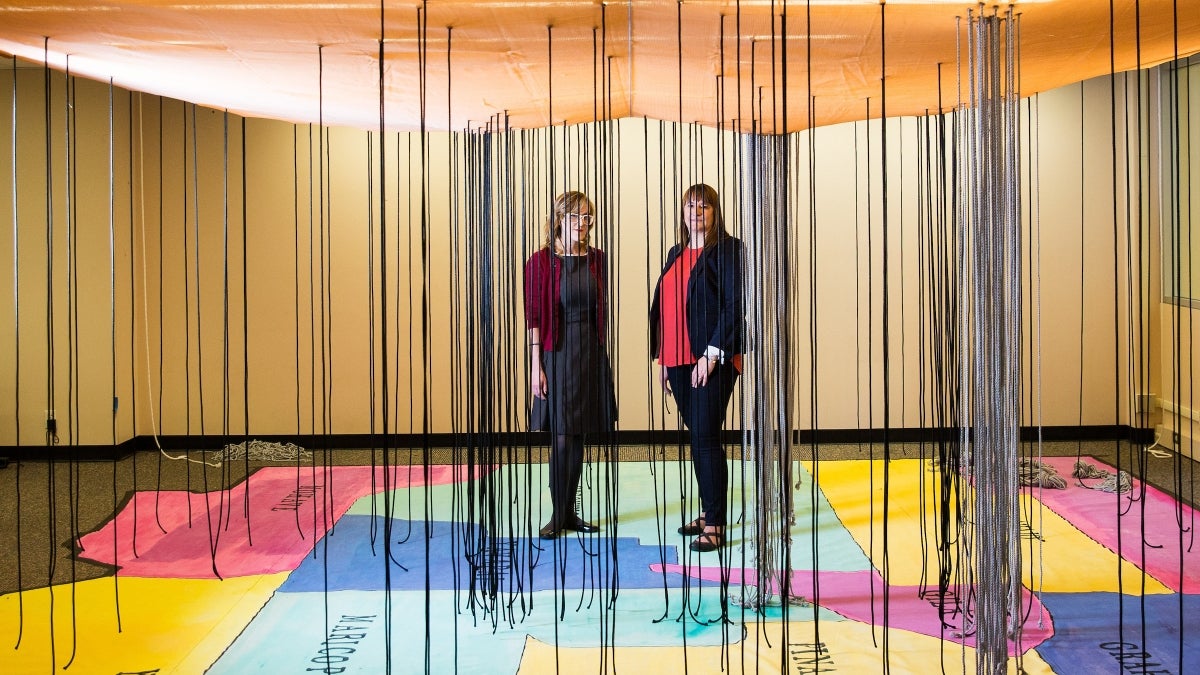So unusual was the 1918 influenza, which killed an estimated 3 to 5 percent of the world’s population, that its symptoms were often misdiagnosed, resembling cholera or typhoid.
As opposed to juveniles, the elderly and those with weakened immune systems, this particular strain of flu virus, commonly referred to as the “Spanish flu,” took its deadliest toll on young adults who were previously healthy.
The speed with which it killed was also remarkable, claiming an estimated 25 million lives in its first 25 weeks and causing life expectancy in 1918 to drop by about 12 years in the United States, alone.
“This flu was unusually dangerous. ... We’re due for another flu like this,” says ASU scholar Jacqueline Wernimont.
Together with Nexus Lab project manager Elizabeth Grumbach, Wernimont — an assistant professor in the Department of English and director of the Nexus Lab, an initiative within the Institute for Humanities Research — has set out to highlight the issue of pandemic with a focus on Arizona.
The two are opening up for public feedback a prototype of their multimedia installation at ASU Library.
"Counting the Dead: Arizona and the Forgotten Pandemic" aims to re-embody Arizona’s influenza mortality data from a century ago, illustrating the ways in which illness had spread across our then-young state.
With this exhibit, the digital humanities scholars are also telling a story many have not heard — that flu deaths in Arizona, in 1918, were underreported by as much as 1,000 percent.
“Much of what we thought we knew about the flu in Arizona is wrong,” Wernimont said.
Counting the dead
ASU Assistant Professor Jacqueline Wernimont shows the cord she has unraveled, which represents 12 influenza deaths in the exhibit "Counting the Dead: Arizona and the Forgotten Pandemic." Visitors are encouraged to unravel the cords, based off Victorian mourning braids, to distinguish the individuals killed by the 1918 flu pandemic. Photo by Deanna Dent/ASU Now
One hundred years ago, Arizona was a young state, not even a decade old — so young, in fact, that it did not yet report mortality statistics to the federal government.
When it comes to flu fatalities, however, a lack of data is not uncommon, Grumbach said.
“Underreported deaths align with what scholarship has said about the flu, but the lack of data for this flu, particularly in Arizona, is unique,” she said.
What the researchers discovered while digging through data from the Arizona State Board of Health — and many, many death certificates — were a lot of holes, specifically in the reporting of Native American deaths.
Working with documents from the Bureau of Indian Affairs and the work of scholars researching flu cases on the Navajo reservation, Wernimont and Grumbach arrived at a much higher total number of deaths in Arizona than had been previously reported.
“The data was messy and incomplete, so getting the numbers right became a much larger part of the project than we had planned,” Wernimont said. “We had started out thinking naively that there was existing data on this, but once we got through all the death records, it became clear there was a disparity between what was reported and the numbers we were uncovering.”
While the State Board of Health reported just 519 influenza-related deaths in 1918, Wernimont and her team have identified 2,228 influenza-related deaths in official death certificates. They estimate nearly 6,000 Arizonans died in the pandemic in 1918 alone. (The full scope of the pandemic extended through 1920 in some places.)
Drawing on the work of flu scholars Benjamin Brady and Howard Bahr, which uses oral history and ethnographic accounts of influenza mortality in Navajo communities, Wernimont estimates that nearly 4,000 Native American deaths were missed in the official influenza mortality statistics.
Between the death certificates and estimates, the ASU team’s work suggests that the official mortality numbers for Arizona are as much as 1,100 percent underreported.
Unfolding of flu in time and space
Video by Deanna Dent/ASU Now
How we experience data is at the heart of Grumbach and Wernimont’s exhibit prototypeIt is located in the upper concourse of Hayden Library (room C2)., which explores alternative ways of understanding — through touch and sound — the unfolding of influenza in time and space.
“We spent a lot of time thinking about how to best memorialize human lives,” Grumbach said.
Wernimont and Grumbach are building on the work Wernimont has executed as part of the Human Security Collaborative, which has taken real-time data from cellphones and presented it as sound and tactile feedback for audiences. This historical project is an extension of that work, Wernimont said.
“We’re interested in how you can take numbers and tell stories in ways that encourage affective and sensorial reactions,” Grumbach said. “How can you re-embody the data — take the numbers out of the table and return it to bodies in order to give it a lasting impact.”
In the same way that a quilt resonated deeply with a nation just waking up to the AIDS epidemic, “data represented by feminized labors, such as textile work, can offer powerful narratives that restore humanity, through acts of care, and spur new thinking around complex issues,” Wernimont added.
Grumbach and Wernimont’s “acts of care” can be seen in almost 500 ropes they’ve cut, tied and suspended from above in Hayden Library. Each rope is a 12-strand braid, with each strand representing one person who died from the flu.
Joining the tactile elements, Wernimont has hand-crafted sonification of the data, giving people a sense of how the flu spread across the year. In addition to experiencing what has already been created, Wernimont and Grumbach are encouraging visitors to participate in the acts of care.
“People are welcome to sit with the mortal ropes and unbraid them, in effect, helping to bring individuals even further out of the aggregated data,” Wernimont said.
“Counting the Dead” will be open to visitors through Nov. 12. A self-guided tour of experiential data in three-dimensional space, the installation prototype is set to coincide with the Society for Literature, Science, and the Arts (SLSA) annual conference, taking place Nov. 7–12 on ASU’s Tempe campus, with the theme “Out of Time.”
“This year’s SLSA conference is about time and memory and spaces,” Wernimont said, “so this fits well with our exhibit. We’re trying to re-embody a forgotten memory.”
Top photo: ASU researchers Elizabeth Grumbach (left) and Jacqueline Wernimont (right) pose with their work on the interactive exhibit, "Counting the Dead: Arizona and the Forgotten Pandemic," on display at Hayden Library through Nov. 12. Each cord represents 12 deaths from the 1918 worldwide influenza pandemic with black cords representing death certificates and gray cords representing oral histories within statistical likelihoods. Photo by Deanna Dent/ASU Now
More Health and medicine

New study seeks to combat national kidney shortage, improve availability for organ transplants
Chronic kidney disease affects one in seven adults in the United States. For two in 1,000 Americans, this disease will advance to kidney failure.End-stage renal failure has two primary…

New initiative aims to make nursing degrees more accessible
Isabella Koklys is graduating in December, so she won’t be one of the students using the Edson College of Nursing and Health Innovation's mobile simulation unit that was launched Wednesday at Arizona…

Reducing waste in medical settings
Health care saves lives, but at what cost? Current health care practices might be creating a large carbon footprint, according to ASU Online student Dr. Michele Domico, who says a healthier…



